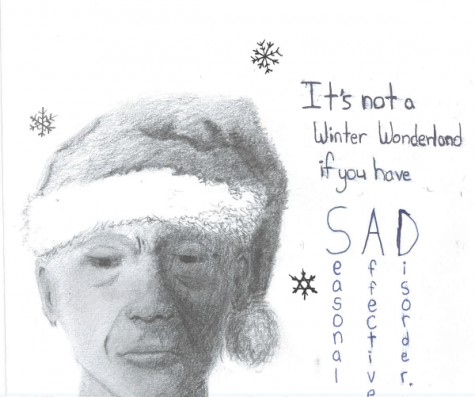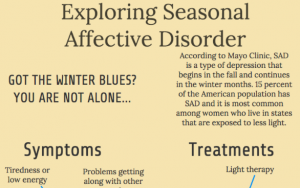Self care combats S.A.D.
February 9, 2019

“Lethargic,” “lack of motivation” and a “sense of hopelessness,” are the words Social Studies and Psychology teacher Roger Stippel used to explain Seasonal Affective Disorder. Seasonal Affective Disorder (SAD) is a type of depression that affects student’s moods negatively during the fall and winter due to the lack of sunlight.
This disorder affects students determination and their day to day lives. There are self-care treatments that help lessen the severity of these miserable symptoms and cope with SAD.
The symptoms of this disorder are fatigue, depression, hopelessness and social withdrawal. Many students become more reserved and do not want to spend time with people or go outdoors. They would rather hide out in their bedrooms keeping their sorrow to themselves.
“It can lead to feeling lethargic, lack of motivation and fatigue,” Stippel said. These are just the main effects of this disorder, but there are a numerous amount of symptoms that vary from person to person.
There are different types of self-care treatment recommended. There is a Happy Light that can be used in the beginning of the day. The light simulates the sun rays that are usually in the summer and spring. This light lessens the effects of SAD.
Other ways to lessen the symptoms are getting outside as much as possible and exercise.
“Even though, you want to just sit on your couch, the best thing that you can do is go get some exercise,” school nurse Melissa Fischer explained.
The key to reduce signs of this disorder is to find what works the best for each person. Some students have found it to be more helpful to simply just hang out with friends as much as they are able to.
Junior Carly Young hangs out with friends for her self support. “I just kind of make sure that I’m not sitting at home all the time,” Young said. “I try to find stuff to do like hang out with friends.”
One of the best options is to first set up a consultation with a doctor to get a diagnosis. Once students are diagnosed then they can move on to useful treatments that are suggested for them.
A diagnosis will lead you in a positive direction. “When they go to a doctor and get diagnosed with this they are recommended what to do,” Stippel said.
“Sad,” “bored” and “lonely,” are the words Young said explained her feelings with having Seasonal Affective Disorder. SAD can be self-cared, students just need to first ask for help.










